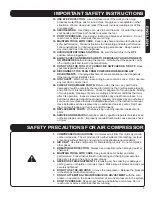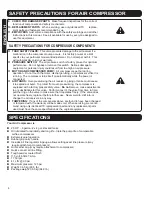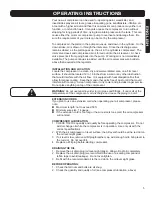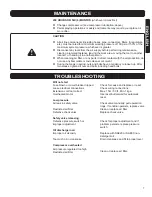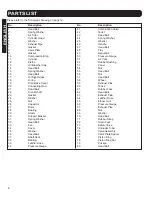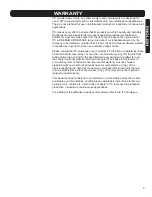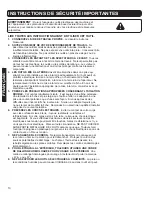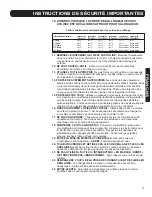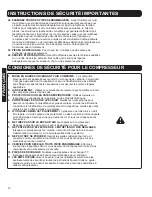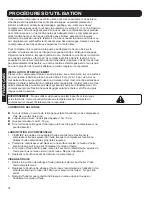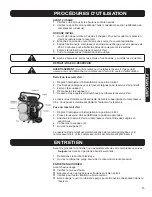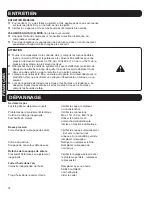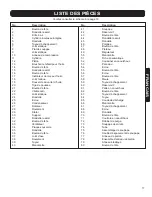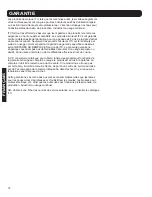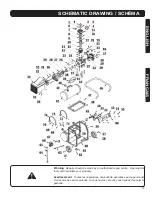
FRANÇAIS
ENGLISH
Your new air compressor can be used for operating paint, weed killer, and
insecticide sprayers, air tools, grease & caulking guns, sandblasters, inflation, etc.
A tool with a higher air demand than this compressor can produce may either not
function, or not function well. It may also cause the compressor to run without
stopping for long periods of time, trying to maintain pressure in the tank. This can
cause either the motor or compressor pump to overheat and damage them. Be
sure the requirements of your tools can be met by the compressor.
To compress air, the piston in the pump moves up and down in the cylinder. On the
down stroke, air is drawn in through the inlet valve. Since the discharge valve
remains closed, as the piston goes up, the air in the cylinder is compressed. The
inlet valve closes and compressed air is forced out into the air receiver. A check
valve prevents it from going back into the pump. Working air is not immediately
available. The pump continues to add air until the air receiver pressure builds to
above that required at the regulator.
INSTALLATION AND LOCATION
Locate the compressor in a clean, dry and well-ventilated area, on a firm level
surface. It should be located 12 to 18 inches from a wall or any other obstruction
that would interfere with the air flow. It is equiped with heat dissipation fins that
allow for proper cooling. Keep them and other parts free of dust or dirt that could
interfere with cooling. A clean compressor runs cooler and provides longer service.
Do not place anything on top of the compressor.
WARNING:
Do not use lead-tin solder to join pipes and fittings. It can melt at the
temperatures of the compressor’s air discharge and cause the piping to burst.
EXTENSION CORDS
If you plan to use an extension cord when operating your air compressor, please
note:
Maximum length: not to exceed 50 ft.
Minimum wire size: 14 gauge.
If the extension cord is too long or the wire size is too small, the air compressor
will not start.
COMPRESSOR LUBRICATION
1. CHECK THE OIL quantity and quality before operating the compressor. Do not
add or change oil while the compressor is in operation. Use only oil with the
correct specifications
2. With the air compressor on level surface, the oil level should be at the red dot on
the oil level sight glass.
3. If oil level is low, remove oil fill plug/breather cap, add enough oil to bring level to
the red dot. Do not over-fill.
4. Replace oil fill plug before starting compressor.
DRAINING THE OIL
1. Remove the oil drain plug (oil level sight glass). Allow oil to drain completely.
2. Replace the oil drain plug (we recommend the use of a sealing compound or
teflon tape to avoid leakage). Do not over-tighten.
3. Refill with the recommended oil to the red dot in the oil level sight glass.
BEFORE OPERATING
:
1. Check that all nuts and bolts are all snug.
2. Check the quantity and quality of oil (see compressor lubrication, above).
OPERATING INSTRUCTIONS



